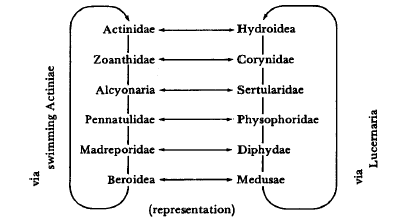November 23, 2003
Trees spring eternal
Trees can be trouble. Over the past month, this blog has seen issues with hypothesized tree structures in semantics (ontology), pragmatics (discourse structure) and syntax. We haven't discussed questions about tree-asserting hypotheses in morphology, phonology and phonetics, but believe me, they're out there.
It seems to be natural for human analytic efforts to produce tree-structured ideas, typically as a result of recursive subdivision of phenomena, whether subdivision of a string of tokens or of a set of entity types. For some naturally-occurring time series (linguistic and otherwise) and for natural kinds of plants and animals, this really works -- tree theories can be an efficient and effective way to organize rational investigation, whether or not they are scientifically valid. This record of success, I think, has reinforced the "things are trees" idea over many millennia of hominid inquiry into nature. A believer in evolutionary psychology might even suppose that our brains have learned to think that things are trees, genetically as well as memetically.
Of course, scientists often find that things are not trees, or at least not exactly. However, non-tree-structured hypotheses are not intrinsically any more likely to be correct. There's a fascinating case in the history of biology, which I learned about some years ago from one of the best books that I ever found in a remainders bin.
Linnaean taxonomy, which classifies all living things into a hierarchy, was developed in the 18th century, but its explanation in terms of Darwin's "descent with modification" did not emerge until more than a century later. In fact, as early 19th-century biologists delved further into the structures and lifecycles of invertebrates from around the world, several of them thought that they saw empirical evidence for non-tree-like patterns of relationship among such creatures. One of these was Thomas Henry Huxley, later famous as a promoter of Darwin's theories.
Darwin went off "botanizing" on the Beagle from 1831-1836 and came back with the evolutionary tree -- descent with modification -- as a new semantics for the Linnaean syntax. But he didn't publish his ideas until 1859. Meanwhile, Huxley went off botanizing on the Rattlesnake from 1846-1850 and returned with a theory of circles of affinity inter-related by parallel cross-links of analogy, as exemplified in this diagram

reproduced from Mary Winsor's fascinating book Starfish, Jellyfish and the Order of Life.
I get the impression that what appealed to Huxley about this "circular theory" (which was inspired by the earlier "Quinary theory" of William Sharp MacLeay) was precisely that it was so different from the common-sense hierarchy of natural kinds, and therefore looked like a real discovery. As a linguist, I'm familiar with the perspective that values "tension between common sense and science."
But Huxley also wrote that
The Circular System appears to me to stand in the same relationship to the true theory of animal form as Keplers Laws to the fundamental doctrine of astronomy--The generalization of the Circular system are for the most part, true, but they are empirical, not ultimate laws---
That animal forms may be naturally arranged in circles is true -- & that the planets move in ellipses is true -- but the laws of centripetal and centrifugal forces give that explanation of the latter law which is wanting for the former. The laws of the similarity and variation of development of Animal form are yet required to explain the circular theory -- they are the true centripetal and centrifugal forces in Zoology.
(Newton's account of Kepler's Laws depends on the single force of gravity, not paired centripetal and centrifugal "fictitious forces", doesn't it? .. but anyhow,) Huxley has the idea that a hypothetical pattern in nature should not simply be accepted (on aesthetic grounds, or as a glimpse of the mind of God), but rather should be given a causal explanation in terms of the dynamics of some simple process. And when he saw that "descent with modification" (with a bunch of other assumptions!) could provide exactly such an explanation for a tree-structured taxonomy of biological species, Huxley immediately abandoned circles for trees.
In linguistics, we can find some similarly fundamental causal arguments for tree structures in terms of the dynamics of basic processes: recursive concatenation in composition; stack discipline in processing; descent with modification in history. But just as in the case of natural kinds in biology, the argument from these basic processes to the structure of real-world phenomena requires lots of extra assumptions. And may be wrong.
Posted by Mark Liberman at November 23, 2003 07:42 AM